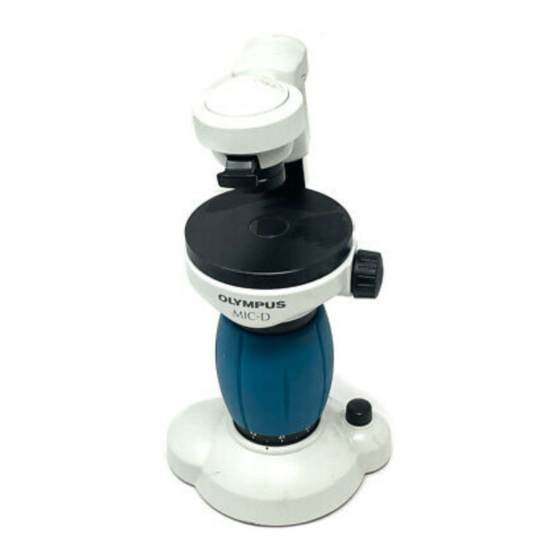Olympus MIC-D Hızlı Başlangıç Kılavuzu - Sayfa 24
Mikroskop Olympus MIC-D için çevrimiçi göz atın veya pdf Hızlı Başlangıç Kılavuzu indirin. Olympus MIC-D 28 sayfaları. Digital microscope
Ayrıca Olympus MIC-D için: Onarım Kılavuzu (43 sayfalar)

22
MIC-D Software
I.ooo-Image
Adjust rne nt
and Manipulation
Most images that you take
will req
uire
very little if a
ny adjustme nt.
Rem ember to e
nte r
the White
Balance
Numbe r (WB#) from
the base of
the
microscop e to maximize color
rendition.
Some
important features to note
and und
erstand
in the
Image
Processing
Window are
:
White
and
Black
Balance
Adjusting the White and Black Balance
e
nsures
that co
rrespo nd ing
a
reas
of
the image
a
re
correctly interpreted by
the
softwa
re,
so that
white areas are
'see n' as being
white
a
nd
'blacks'
as
black.
To pe
rform
a
White Balance operation,
se
lect an
area of
the image
that you
think shou ld
be
white.
This
is the region you will te
ll the
processing software it
should inter pret
as be
ing white in
case
it
is
tinted.
If th
is
area
is very
small (just
a few
pixels) then
use
the
'Po
int'
sampling
tool, which will
e
nable
you to
sample
a very
small
a
rea or
poi
nt.
If
the
region is larger, use
the
'Area' tool to draw a box ove
r
a
'white'
part
of the
image
.
Next,
click
on
the
'Select
White Balance' button
a
nd
d
raw
a box ove
r
a
n
a
rea of
the image
with
the
cursor that you th
ink o
ught
to a
ppear white .
A
single
click
of
the mouse
over
a w
hite area
is
sufficie nt
if
you
are using the
'Point' sampling
too
l.
Next,
click
on
'Apply
White Balance'
.
Note
the slight
d
ifference in
the
image.
Carry
o
ut
the
co
rrespo nd ing Black Balance
ad
justme nt,
if you
think that the re
a
re
region s of
the image
that
ought
to appea
r
black.
Digital
Versus Optical Zoomi ng
The
Digital Zoo
m
is
useful for
zooming
in
o
n
a
captured
image.
It is important to note
that
digital
zooming is quite differe
nt from optical
zoom
ing (pe rformed
with
the MIC-D
Microscope itself.) When
you zoo
m
d
igitally, you are merely
e
nlargi ng
a
fixed
number
of
pixels
so that they
are
spread ove
r
a large r
space on the computer monitor
or in print.
Detai
l
is not added to
the
image
.
Existing detail
is merely
expanded.
So, a te
n pixel
by
te
n
pixel digital
image (100
pixel a
rea) that
is
blown
up two
times will still
o
nly
co
ntai n
one
hundred pixels
worth of
image
information.
W
hen an
O
ptical
Zoo
m
is
increased in
power,
the
light recieved from
the
act
ual speci me n or samp le
(conta
ining
detail
that
could
not be detected at a lower magnification
because
it was too
small or
too
fine)
is
revealed.
An
a
rea of
a specimen
that
spa
ns
a 100
pixels
area
in
the Live Image
Window
will
be
seen
by
four times
that number of
pixels
afte
r
two
times optical
zoo
ming, with
fou
r times
as
much visible
detail revea
led.
Di
gital
Z
oom
O
ptical
Z
oom
•
'"
Vs.
•
,
~6i
'
:
.
,
"
-
.
